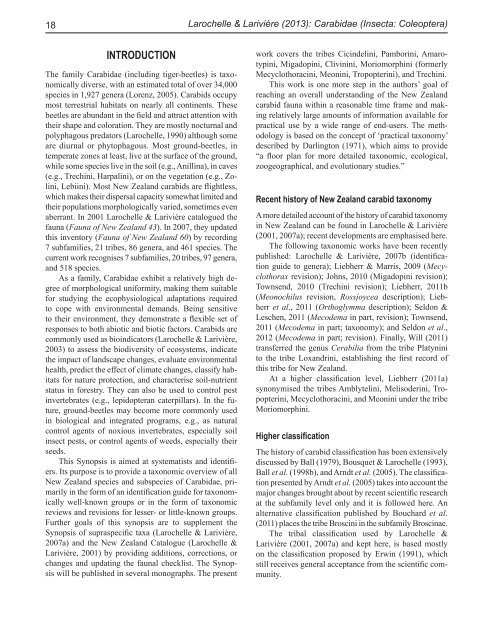Fauna of New Zealand 69 - Landcare Research
Fauna of New Zealand 69 - Landcare Research
Fauna of New Zealand 69 - Landcare Research
You also want an ePaper? Increase the reach of your titles
YUMPU automatically turns print PDFs into web optimized ePapers that Google loves.
18<br />
INTRODUCTION<br />
The family Carabidae (including tiger-beetles) is taxonomically<br />
diverse, with an estimated total <strong>of</strong> over 34,000<br />
species in 1,927 genera (Lorenz, 2005). Carabids occupy<br />
most terrestrial habitats on nearly all continents. These<br />
beetles are abundant in the field and attract attention with<br />
their shape and coloration. They are mostly nocturnal and<br />
polyphagous predators (Larochelle, 1990) although some<br />
are diurnal or phytophagous. Most ground-beetles, in<br />
temperate zones at least, live at the surface <strong>of</strong> the ground,<br />
while some species live in the soil (e.g., Anillina), in caves<br />
(e.g., Trechini, Harpalini), or on the vegetation (e.g., Zolini,<br />
Lebiini). Most <strong>New</strong> <strong>Zealand</strong> carabids are flightless,<br />
which makes their dispersal capacity somewhat limited and<br />
their populations morphologically varied, sometimes even<br />
aberrant. In 2001 Larochelle & Larivière catalogued the<br />
fauna (<strong>Fauna</strong> <strong>of</strong> <strong>New</strong> <strong>Zealand</strong> 43). In 2007, they updated<br />
this inventory (<strong>Fauna</strong> <strong>of</strong> <strong>New</strong> <strong>Zealand</strong> 60) by recording<br />
7 subfamilies, 21 tribes, 86 genera, and 461 species. The<br />
current work recognises 7 subfamilies, 20 tribes, 97 genera,<br />
and 518 species.<br />
As a family, Carabidae exhibit a relatively high degree<br />
<strong>of</strong> morphological uniformity, making them suitable<br />
for studying the ecophysiological adaptations required<br />
to cope with environmental demands. Being sensitive<br />
to their environment, they demonstrate a flexible set <strong>of</strong><br />
responses to both abiotic and biotic factors. Carabids are<br />
commonly used as bioindicators (Larochelle & Larivière,<br />
2003) to assess the biodiversity <strong>of</strong> ecosystems, indicate<br />
the impact <strong>of</strong> landscape changes, evaluate environmental<br />
health, predict the effect <strong>of</strong> climate changes, classify habitats<br />
for nature protection, and characterise soil-nutrient<br />
status in forestry. They can also be used to control pest<br />
invertebrates (e.g., lepidopteran caterpillars). In the future,<br />
ground-beetles may become more commonly used<br />
in biological and integrated programs, e.g., as natural<br />
control agents <strong>of</strong> noxious invertebrates, especially soil<br />
insect pests, or control agents <strong>of</strong> weeds, especially their<br />
seeds.<br />
This Synopsis is aimed at systematists and identifiers.<br />
Its purpose is to provide a taxonomic overview <strong>of</strong> all<br />
<strong>New</strong> <strong>Zealand</strong> species and subspecies <strong>of</strong> Carabidae, primarily<br />
in the form <strong>of</strong> an identification guide for taxonomically<br />
well-known groups or in the form <strong>of</strong> taxonomic<br />
reviews and revisions for lesser- or little-known groups.<br />
Further goals <strong>of</strong> this synopsis are to supplement the<br />
Synopsis <strong>of</strong> supraspecific taxa (Larochelle & Larivière,<br />
2007a) and the <strong>New</strong> <strong>Zealand</strong> Catalogue (Larochelle &<br />
Larivière, 2001) by providing additions, corrections, or<br />
changes and updating the faunal checklist. The Synopsis<br />
will be published in several monographs. The present<br />
Larochelle & Larivière (2013): Carabidae (Insecta: Coleoptera)<br />
work covers the tribes Cicindelini, Pamborini, Amarotypini,<br />
Migadopini, Clivinini, Moriomorphini (formerly<br />
Mecyclothoracini, Meonini, Tropopterini), and Trechini.<br />
This work is one more step in the authors’ goal <strong>of</strong><br />
reaching an overall understanding <strong>of</strong> the <strong>New</strong> <strong>Zealand</strong><br />
carabid fauna within a reasonable time frame and making<br />
relatively large amounts <strong>of</strong> information available for<br />
practical use by a wide range <strong>of</strong> end-users. The methodology<br />
is based on the concept <strong>of</strong> ‘practical taxonomy’<br />
described by Darlington (1971), which aims to provide<br />
“a floor plan for more detailed taxonomic, ecological,<br />
zoogeographical, and evolutionary studies.”<br />
Recent history <strong>of</strong> <strong>New</strong> <strong>Zealand</strong> carabid taxonomy<br />
A more detailed account <strong>of</strong> the history <strong>of</strong> carabid taxonomy<br />
in <strong>New</strong> <strong>Zealand</strong> can be found in Larochelle & Larivière<br />
(2001, 2007a); recent developments are emphasised here.<br />
The following taxonomic works have been recently<br />
published: Larochelle & Larivière, 2007b (identification<br />
guide to genera); Liebherr & Marris, 2009 (Mecyclothorax<br />
revision); Johns, 2010 (Migadopini revision);<br />
Townsend, 2010 (Trechini revision); Liebherr, 2011b<br />
(Meonochilus revision, Rossjoycea description); Liebherr<br />
et al., 2011 (Orthoglymma description); Seldon &<br />
Leschen, 2011 (Mecodema in part, revision); Townsend,<br />
2011 (Mecodema in part; taxonomy); and Seldon et al.,<br />
2012 (Mecodema in part; revision). Finally, Will (2011)<br />
transferred the genus Cerabilia from the tribe Platynini<br />
to the tribe Loxandrini, establishing the first record <strong>of</strong><br />
this tribe for <strong>New</strong> <strong>Zealand</strong>.<br />
At a higher classification level, Liebherr (2011a)<br />
synonymised the tribes Amblytelini, Melisoderini, Tropopterini,<br />
Mecyclothoracini, and Meonini under the tribe<br />
Moriomorphini.<br />
Higher classification<br />
The history <strong>of</strong> carabid classification has been extensively<br />
discussed by Ball (1979), Bousquet & Larochelle (1993),<br />
Ball et al. (1998b), and Arndt et al. (2005). The classification<br />
presented by Arndt et al. (2005) takes into account the<br />
major changes brought about by recent scientific research<br />
at the subfamily level only and it is followed here. An<br />
alternative classification published by Bouchard et al.<br />
(2011) places the tribe Broscini in the subfamily Broscinae.<br />
The tribal classification used by Larochelle &<br />
Larivière (2001, 2007a) and kept here, is based mostly<br />
on the classification proposed by Erwin (1991), which<br />
still receives general acceptance from the scientific community.
















